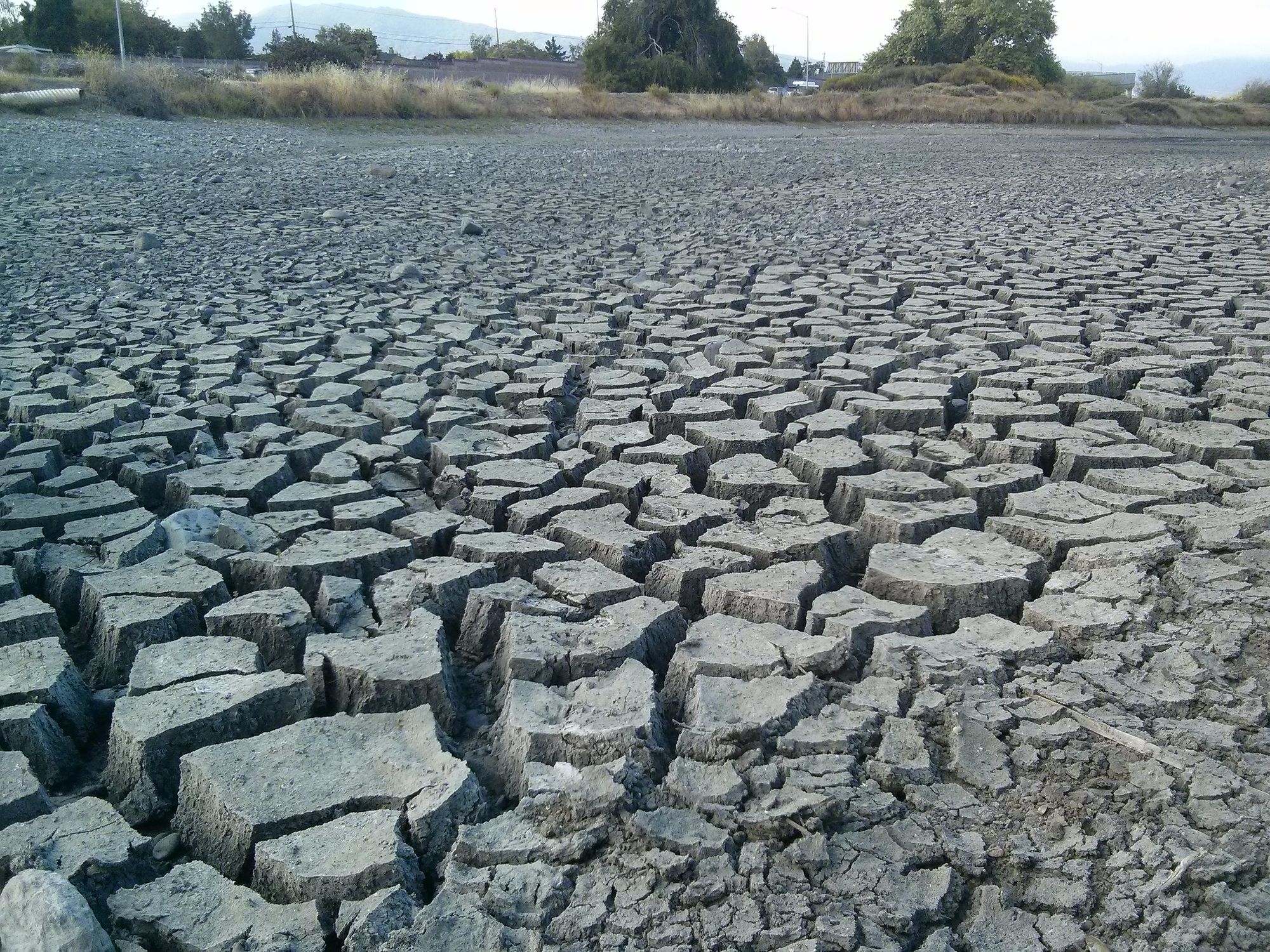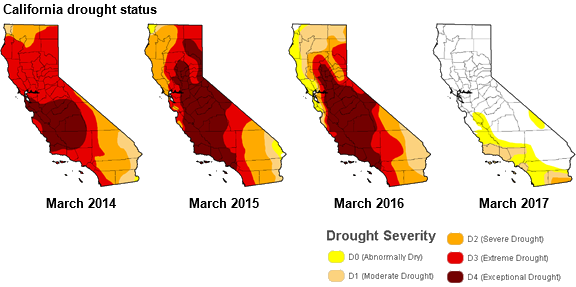After Driest February on Record, Is Another California Drought Inevitable?
The state witnessed its driest February on record this year, and climate scientists are worried about the possibility of another California drought.

February ended without a single drop of rain in downtown San Francisco, Pas Robles, Big Sur State Park, and other parts of California. The state witnessed its driest February on record this year, and climate scientists are worried about the possibility of another California drought.
The lack of snow and rainfall in February was made even worse by a drier-than-average January in the state. The situation is worrisome because 90% of California’s rains fall between the start of October and the end of April, with the months of December, January, and February the peak of it all. The storms in December triggered a sense of optimism about the prospects of a normal winter. January, and most certainly, February, dashed those hopes.

The February rains in California are very important because it is a source of nourishment for the plants and reservoirs. It also replenishes the snows in the Sierra Nevada Mountains which delivers 30% of the drinking water in the state.
The lack of moisture and soaring temperatures, linked to climate change, means that fears of another lengthy drought are completely legitimate.
376 Weeks of Drought
Between December 27th, 2011 and March 5th, 2019, California experienced 376 consecutive weeks of drought. The National Drought Mitigation center announced the end of the drought on March 14th, 2019.
During this period, the state saw deadly wildfires and heavy mudslides. There was also a household water shortage, and agricultural production took a hit. At the peak of the drought in 2014, the state was visibly dry even from space. Residents in some parts of the state had to start buying bottled water for everyday water needs. The end of the drought led to an improvement in water levels across the state as reservoirs, lakes, and streams started flowing again.
However, even amidst the celebrations, scientists warned that another drought might follow if the conditions that ended the drought did not last long enough. The warning holds more meaning today as the state braces for the possible impact of the driest February on record.
The 7-year Drought’s Impact on California Housing
During the 7-year drought, the government imposed a 25% cut on water consumption which affected agricultural production and everyday living. However, the California housing market remained largely unaffected. Around the peak of the drought in 2015, the housing market was healthier than it had ever been since after the 2008 financial crisis. Growth in the sector was not concentrated in one region either as it spread from San Diego to the Bay Area. Even in areas where agriculture was affected by the water consumption cuts, builders didn’t relent on new constructions.
Will the housing market be affected if the dry autumn and winter lead to another drought? Nothing suggests that we will see any slowdown in construction. Barring any government-related actions, the housing sector will continue to dip into depleting water reserves to take advantage of rising demand and low mortgage rates.
Unusually Dry Autumn and Winter
The last time downtown San Francisco was as dry as February 2020 was in 1864. Northern California, on its part, has never had any autumn or winter as dry as the current one. The impact of climate change over the years has caused the state to witness record-breaking dryness in a month that is typically the wettest in most years. This is because warmer temperatures are expected to worsen the state’s volatile precipitation patterns.
With increasing temperatures, droughts will be more severe, and the rains will be heavy when they come. Therefore, California can expect more dry days while hoping that fewer but more intense storms can deliver the year’s water supply.
March 2020, is where the Climate Prediction Center expects the current dry spell to break up. Their analysis shows a 50% chance of above-average precipitation across the majority of the state. If the predictions don’t become a reality, it could be a really hairy summer ahead.
Susceptibility of the State to Fires
California’s drought conditions have made it very prone to wildfires. The 11 fires in #CostaCounty on the 4th of July 2019 is one of the best examples of how the current conditions can turn a small fire into a raging inferno that can level acres over a short period. Firefighters mentioned that most of the fires were started when fireworks mixed with warm weather, low humidity, windy conditions, and dry vegetation.
As of February 5th, 2020, a total of 94 wildfires have already burned 110 acres across California. If the current dry weather persists, there is a high chance that the state will see another 8,000-fire year as was the case in 2019.
Dramatic Ways California Is Tackling Drought
Although the state of California can do a lot more to drive conservation and fight climate change, it is definitely doing more than some states in the US to help the environment.
The United States Climate Alliance
In June 2017, the US government moved away from the Paris Agreement on climate change. However, the state of California did not support this decision. Together with Washington and New York, it formed the United States Climate Alliance, which is designed to honor the terms of the agreement. The state is also at loggerheads with the federal government over the car emission restrictions.
Designation of Lompico
In January 2014, California designated Lompico as an area that could run out of water. This allowed it to allocate around $160,000 for the development of an intertie. This emergency piping structure connected Lompico to the San Lorenzo Water District.
The Sacramento Water Contingency plan
The Sacramento city council made the water shortage contingency plan into law in 2014 as it targeted a 20% reduction in water consumption. The plan also restricted watering of lawns to two times a week maximum, and it also paid residents up to $1,000 to replace the plants on their front lawns with drought-resistant varieties.
The Fair Oaks Agreement
The American River in Fair Oaks, #SacramentoCounty is not just a water source. It is also a tourist attraction that brings kayakers, rafters, and bikers to the small town of 30,000 people each year. As soon as the town began to see the impact of the 7-year drought on the river, an agreement to protect the river was drawn up between businesses and other groups in the area, as well as nearby water districts.
The town invested millions into drilling wells as backup water supply which it uses to supply cities that rely on the American River with water once the surface water supply is not at the optimal level. This way, the river’s water level will remain high enough to solve the demands of the immediate environment and ecosystem.
Montecito Water Emergency
The city of #Montecito declared a water emergency on February 11, 2014. This allowed it to start water rationing in the area. Under the new regulations, there were penalties imposed for draining pools, exceeding outdoor watering limits, etc. During the early days of the ban, some residents were fined up to $2000 for exceeding their approved water allotments.
The Startups Fighting Drought
Entrepreneurs in California have joined in the fight against drought by inventing solutions that can create more water all across the state.
Sea Cliff Homes
In the Sea Cliff Homes property development, a gray water recycling system is used to treat water from the showers, bathroom sinks, and washing machines, making them reusable for flushing toilets and irrigating the yard.
OndaVia
This company manufactures a portable water test kit (PDF) that can detect harmful water pollutants in minutes. When combined with other solutions, this technology can help the state discover more usable water.
Baswood and Microvi Biotech
Baswood launched a BioViper water treatment system that can treat wastewater by copying the natural method of breaking down organic matter. Microvi created a process that hastens up the removal of perchlorate, nitrate, chlorinated solvents and more from the water. With this technology, the company can help provide millions of gallons of usable water by converting harmful nitrates to harmless gas.
Sky Water Alliance
The company’s “WeDew” solution cools warm air and converts it to drinkable water inside a tank that can serve up to 100 people per day.
Making Water Conservation the California Way of Life
The Water Conservation and Drought Planning legislation of 2018 was designed to help the state of California to adopt water conservation principles. The legislation was a response to Governor Jerry Brown’s executive order of 2016 to make water conservation a normal way of life. The six main components of the legislation include:
- Drought planning for small water systems and rural communities
- Agricultural water management planning
- Annual water supply and demand assessments
- Data reporting and transparency
- Customized water use targets for urban water supplier
Conclusion
As more people talk about the driest month in the history of California, it is important to keep in mind that it is NOT a one-off occurrence. As climate change continues to push temperatures higher, there is a high probability that there will be more months in the future like February 2020.
As it stands, the March precipitation is the main hope of preventing a slip into a drought again just as the state is recovering from the 7-year drought. Even if the weather predictions are 100% accurate, the rains expected in March may still not be enough to solve the state’s water needs until the next winter.
As more wildfires tear through the state as a result of plummeting vegetation moisture, the state of California needs more concerted efforts to combat climate change and become less prone to the wild swings of its precipitation patterns.
Augurisk is an innovative platform for climate change risk assessment. We also offer assessments for natural hazards and societal risks. Is your home or business at risk? Get a free risk assessment today at Augurisk.com.
